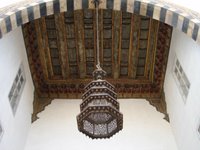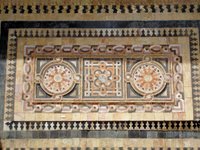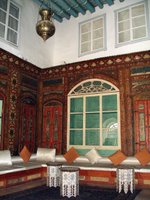Bayt al-‘Aqqad
 The house has been built on the ruins of Herod the Great’s theater from the 1st century B.C. a substantial remains of Roman walls appeared embedded in the mud walls of the ‘Aqqad-house.
The house has been built on the ruins of Herod the Great’s theater from the 1st century B.C. a substantial remains of Roman walls appeared embedded in the mud walls of the ‘Aqqad-house.
After the Mongol destruction of Damascus in 1400-1401 it took long time for the city to recover. But especially during the reign of Mumluks a number of impressive  buildings were erected, some of them in the immediate neighborhood of the ‘Aqqad-house. There are reasons to believe that essential parts of the qa’a and the iwan are fragments of a monumental Mamluk building, possibly a palace, from this period (late 15th century). It is interesting in this context that many shreds of glazed Syrians, Persian and Chinese pottery form the 13th – 15th century were
buildings were erected, some of them in the immediate neighborhood of the ‘Aqqad-house. There are reasons to believe that essential parts of the qa’a and the iwan are fragments of a monumental Mamluk building, possibly a palace, from this period (late 15th century). It is interesting in this context that many shreds of glazed Syrians, Persian and Chinese pottery form the 13th – 15th century were  found at the house during the restoration.
found at the house during the restoration.
there is no evidence of building activities at the ‘Aqqad-house during the 16th and 17th centuries. But during the 2nd half of the 18th century a building is added at the North-eastern corner of the courtyard is laid, the Mamluk qa’a is renovated (an inscription in the qa’a gives the date 1754/55), a new courtyard is laid out, and several rooms are embellished with painted wall-panels and ceilings. the painting of two of theses rooms are dated by inscriptions to 1763/64.
the painting of two of theses rooms are dated by inscriptions to 1763/64.
The owner of ‘Aqqad-house in the 18th century are not known. By the middle of the 19th century the house was owned by the ‘Aqqad family, who redecorated some of the rooms like the “blue room” which is a fine example of the
so-called Turkish Rococo style appearing for the first time in Syria in the 1840s.
During the first half of the 10th century the house was still inhabited by members of the Aqqad family, later it was used by the Zainab Fawaz School. However during the last twenty years of the century most of the house was left empty and quicky decayed.
On June 19,1997 a Lease Restoration Agreement was signed in Damascus between the Ministry of Culture, and the Directorate General of Antiquities and Museums (Syria), and the Ministry of Education and the Danish Institute in Damascus (Denmark). In the agreement, the rules for the expropriations and restoration of the house in the Old City of Damascus, as well as the future lease and use of the house by the Danish institute were laid out. The Danish Institute was officially inaugurated in November 2000.
In the agreement, the rules for the expropriations and restoration of the house in the Old City of Damascus, as well as the future lease and use of the house by the Danish institute were laid out. The Danish Institute was officially inaugurated in November 2000.
Aqqad-house/ The Danish Institute in Damascus is situated in Souq al-Souf near Souq Madhat Pasha.
Source: The Danish Institute in Damascus.










5 Comments:
Your blog is one of the few best Syrian Blogs, it’s amazing, it keeps reminding me of my homeland, thank you Ghalia very much. Keep it up.
By Anonymous, at 20/11/05 11:03 AM
Anonymous, at 20/11/05 11:03 AM
Beautiful. I like these houses. I dream of living in it :)
By Hovic Atokian, at 20/11/05 11:17 AM
Hovic Atokian, at 20/11/05 11:17 AM
ive been to syria 3 or 4 times, I thank you for the pix you share, wonderful pictures and posts. Thank you Ghalia
By Sabri Hakim, at 22/11/05 11:14 AM
Sabri Hakim, at 22/11/05 11:14 AM
This is really nice, not only by it's exetrior look, but also by what it means or represents. Indeed this old house damascus house speaks to the one that visits it or sees through your blog.
Indeed living in a damascus style house like that or similar to it, is also one of my dreams. Going Syria along with the familly and participate in such rich cultural event.
By Anonymous, at 23/11/05 11:13 PM
Anonymous, at 23/11/05 11:13 PM
Thank you guys, and to Mr. Elie, I hope ur dream to come ture one day.
By Ghalia, at 23/11/05 11:30 PM
Ghalia, at 23/11/05 11:30 PM
Post a Comment
<< Home